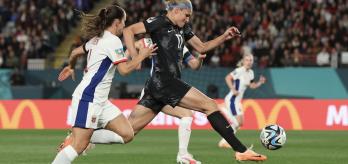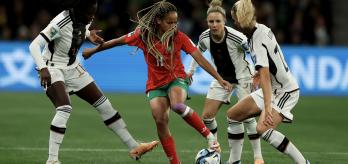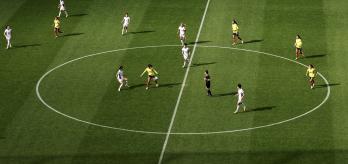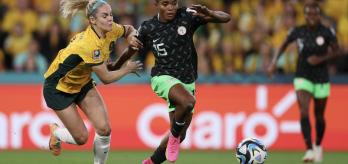Nigeria produced one of the tournament's biggest upsets to date with their 3-2 victory over the co-hosts at Brisbane's Lang Park. Nigeria's physical and organised defensive display disrupted Australia's attacking rhythm, and the Super Falcon's direct attacking intent proved devastating and ultimately decided the game. In this article, Touré and Grainger break down the critical elements of Nigeria's strategy, both in and out of possession.
Key insights
-
A team's structure can change depending on whether they are in or out of possession. A common reason for adopting a different out of possession structure is to match the opposition player for player in certain areas of the field.
-
Out of possession defending players must decide when to protect the space and stay compact as a team (known as 'ball-orientated' defending) and when to mark their opponents more closely (known as 'player-orientated' defending).
-
There is a link between the characteristics of individual players and their team's defending principles. A team with more physical players can benefit from a more player-orientated defending style as they can excel in applying direct pressure and engaging in individual duels with opposition players.
Line-ups
A player-orientated mid-block
Nigeria spent roughly 50% of their time out of possession in a low or mid-block phase. This indicates they had a clear strategy for where they wanted to defend on the pitch. Out of possession, the Super Falcons would set up in 4-1-4-1, which differed from the 4-2-3-1 they adopted in possession. By adopting a 4-1-4-1 formation without the ball, Nigeria would match Australia's shape in midfield.
This decision to adopt a 4-1-4-1 went hand in hand with Nigeria's player-orientated mid-block. Player-orientated defensive systems compromise traditional player-to-player marking and the more modern, zonal approach to defending. They also allow defenders to mark opposition players closely at the same time as protecting space. Nigeria's system meant individual players had clear roles and responsibilities, as seen in the series of images below.
Defensive organisation and pressing triggers
In theory, there are two main types of defensive systems: "ball-orientated" systems, in which defending players position themselves depending on where the ball is on the pitch, and "player-orientated" systems, in which defensive positioning is based on how opposition players are moving around the field. In practice, players and teams always naturally consider both factors but may emphasise one over the other.
A key characteristic of Nigeria's defensive display was how they matched the opposition player for player. The Super Falcons' midfielders would mark their opposite numbers relatively closely and track their movements inside the Nigeria mid-block (see clips at the end of this section).
However, Nigeria's defending system was not purely player-orientated. When the opponent offered to receive a pass outside Nigeria's mid-block, the team sometimes decided to keep shape instead of following their counterparts. Grainger noted, "Australia sometimes would drop players into a false full-back position and Nigeria wouldn't follow. It wasn't purely a player-for-player marking system because if it were, a Nigerian player would've followed this player out into the false full-back position and be aggressive."
Instead, Nigeria had a selection of pressing triggers that would determine whether they would actively engage their opponent. Whether these triggers were activated depended on several factors, such as the proximity of the Australia player receiving the ball to Nigeria's mid-block and the position of the Nigeria mid-block itself. Touré and Grainger identified four triggers used by the Super Falcons during their match against Australia.
The link between individual strengths and the defending system
Nigeria are a side comprised of fast and physical players. As a group, Nigeria could harness their individual strengths and channel them into an effective team performance, underpinned by their sophisticated defensive system. Touré observed this after the game, "physically speaking, they were able to manage the game from the beginning to the end. They brought a very strong physical rhythm, and collectively speaking, this might be their main strength."
Direct attacks
In possession, Nigeria had a strategy of direct attacking intent. They would constantly look to progress the ball towards Australia's goal both during attacking transitions and more established phases of possession as early and as quickly as possible. However, spending 26% of their time in unopposed build-up and 20% in attacking transitions reveals that the Super Falcons also had a balanced approach in retaining possession and progressing play up the pitch. Although always eager for the direct play, Nigeria would only force a direct attack if conditions were favourable.
Transitions from defence to attack
The attacking transition was one phase of play where Nigeria's directness came to the fore (Clip 5 & 6). At the individual level, players possessed a speed of thought when regaining the ball, always looking to see if a forward pass or counter-attack were possible. Collectively, the Nigeria players ahead of their team-mate who regained possession would play on the front foot. If the attack progressed into the final third, Nigeria strove to attack Australia's penalty area with multiple players.
Winger Rasheedat Ajibade (15) was a cornerstone of Nigeria's direct attacks against Australia (see Graphic 4). "Ajibade is an amazing player," Touré explained, "The system put in place by Nigeria is very orientated towards the left side. This is because of Ajibade [who switched to the left wing in the 35th minute]. She always offers for the ball; when she receives it, she can pass opposition players as she's very quick and precise. I think the Nigeria team is trying to use her skill set as much as possible."
Goal kicks: direct and lethal
Nigeria's goal kicks were another area of the game that demonstrated the directness of their attack. In these situations, instead of building out from the back Nigeria goalkeeper Chiamaka Nnadozie (16) would play the long ball, targeting her front line (Clip 7 & 8). "Because of their athleticism and physical capabilities, you can't switch off for a moment," stressed Grainger, "any ball played into the space in behind Australia's backline is a huge problem because of Nigeria's pace and the pressure they can apply on the player attempting to clear the goal kick." This type of dead-ball situation preceded two of the Super Falcons ' three goals.
FIFA Goalkeeping Expert Pascal Zuberbühler was also impressed by Nigeria's direct goal kicks. For him, this further proves the point that goalkeepers and teams need a variety of distributions from goal kicks. "Long kicks are a legitimate solution and should be part of every team's repertoire. In these specific situations, it is important that the kick is of sufficient length and that the field players form a compact block so that the battle for the first and second ball can be won," he explained. The two central midfielders Payne (7) and Ucheibe (10) were particularly successful in winning second balls (see Graphic 6 & 7). Payne received 5 times from possession contests and 6 times from loose balls. Ucheibe collected a total of 13 loose balls. As seen in Clip 7 and 8, Nigeria thrived with the direct goal kick, consequently troubling Australia's defence.
Decision-making and harnessing individual strengths
The Super Falcons ' performance demonstrated why decision-making matters in football. Because defending systems are nuanced, players need to know when to follow opposition players and when to hold their own team's shape. In possession, a team needs to know when to decide to attack directly and when to retain the ball. There is no right or wrong choice in these scenarios; teams choose their actions in different ways and for different reasons. However, to guarantee a strong performance, players must make these decisions as a team, consistently and in a way that allows their strengths to flourish. Against Australia, Nigeria successfully navigated these scenarios collectively and in a way that best suited their physicality and athleticism.

















